Use 'Print preview' to check the number of pages and printer settings.
Print functionality varies between browsers.
Printable page generated Wednesday, 24 April 2024, 10:54 AM
Family Planning Module: 8. Barrier Contraceptive Methods
Study Session 8 Barrier Contraceptive Methods
Introduction
Barrier contraceptive methods are another type of contraceptive method used for preventing pregnancy and certain sexually transmitted infections. Various male and female barrier methods of contraception have been in use for centuries, and they are one of the oldest methods in use. They are designed to prevent the passage of sperm into the uterus during the sexual act. The success of such methods depends on the quality of the barriers, and the motivation and willingness of the couple to use the method. The male condom is the only male barrier known, while a number of different female barriers exist, such as the diaphragm, female condom and cervical cap, all of which are widely available. Spermicides are often used in conjunction with barrier methods. They are chemical barriers which can also be used on their own.
In this study session, you will learn about the various barrier methods, their types and mechanism of actions, their effectiveness of use, and the advantages and disadvantages of each.
Learning Outcomes for Study Session 8
When you have studied this session, you should be able to:
8.1 Define and use correctly all of the key words printed in bold. (SAQs 8.1 and 8.6)
8.2 Describe the types of barrier contraceptives. (SAQs 8.2 and 8.6)
8.3 Describe the mechanism of action, use, effectiveness, advantages and disadvantages of the male condom. (SAQs 8.2, 8.3, 8.4 and 8.6)
8.4 Explain the use, advantages and disadvantages of the female condom. (SAQs 8.5 and 8.6)
8.5 Discuss the use, advantages and disadvantages of using diaphragms. (SAQ 8.6)
8.6 Describe the mechanism of action, effectiveness and advantages of spermicides. (SAQ 8.6)
8.1 Types of barriers
Barrier contraceptives are broadly classified into two main types: mechanical barriers and chemical barriers.
8.1.1 Mechanical barriers
Mechanical barriers are devices that provide a physical barrier between the sperm and the egg. Examples of mechanical barriers include the male condom, female condom, diaphragm, cervical cap, and sponge. The condom is the only contraceptive method that helps prevent sexually transmitted infections (STIs).
8.1.2 Chemical barriers
Chemical barriers or spermicides are sperm-killing substances, available as foams, creams, gels, films or suppositories, which are often used in female contraception in conjunction with mechanical barriers and other devices. Spermicides are usually available without a prescription or medical examination.
8.2 The male condom
The male condom is one of the most widely used barrier methods in the world. In Ethiopia, it has perhaps been the only barrier method ever known and used. Thus, in this study session, more emphasis will be given to the male condom than to any other barrier method and you will learn about it in detail.
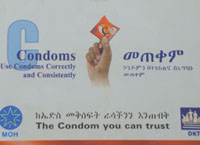
8.2.1 Mechanism of action
A male condom is a covering made to fit over a man’s erect penis. It can also be called a rubber, sheath or skin, and is known by many different brand names. It works by providing a barrier between partners during sexual intercourse, so that bodily fluids, such as semen and blood, are not shared. As a result, pregnancy and reproductive tract infections (RTIs), including human immunodeficiency virus (HIV), and acquired immunodeficiency syndrome (AIDS), can be prevented. Most condoms are made of thin latex rubber. Some condoms are coated with a dry lubricant or with spermicide. Different sizes, shapes, colours and textures are common.
8.2.2 Effectiveness
Condoms can be very effective in preventing pregnancy when used consistently and correctly. The pregnancy rate for couples who use condoms every time they have intercourse is estimated to be 3% per first year of use.
Condoms also help prevent sexually transmitted diseases (STDs or STIs). During sexual intercourse, condoms can stop the sexual transmission of many diseases, including gonorrhoea, syphilis, chlamydia, HIV/AIDS and trichomoniasis (refer to your Communicable Diseases Module).
8.2.3 How to use a male condom
In this section, you will learn how a male condom is used. Table 8.1 shows you the basic steps. You can learn how to demonstrate it using wooden models or toys. You need to practise it on your own, or aided by your mentor, so that you can demonstrate it to any client in your community. Eventually, you will need to ask your client to demonstrate it back to check that the process has been understood.
| Steps | Description | Illustration |
|---|---|---|
| 1 Use a new condom for each sex act. | Check the condom package. Do not use the condom if it is torn or damaged. Avoid using an expired condom. Do so only if a newer condom is not available. Tear and open the package carefully. Do not use fingernails, teeth, or anything that can damage the condom. |  |
| 2 Before any physical contact, place the condom on the tip of the erect penis with the rolled side out. | For the best protection, put the condom on before the penis makes any genital contact. | 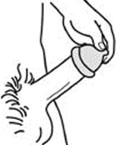 |
| 3 Unroll the condom all the way to the base of the erect penis. | The condom should unroll easily. Forcing it on could cause it to break during use. If the condom does not unroll easily, it may be on backwards, be damaged, or be too old. Throw it away and use a new condom. If the condom is on backwards and another one is not available, turn it over and unroll it onto the penis. |  |
| 4 Immediately after ejaculation, hold the rim of the condom in place and withdraw the penis while it is still erect. | Withdraw the penis. Slide the condom off, avoiding spilling semen. If having sex again, use a new condom. | 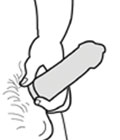 |
| 5 Dispose of the used condom safely. | Wrap the condom in its packaging and put it in the rubbish or latrine. Keep it away from the reach of children. | 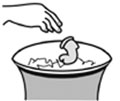 |
Condom failure
Condoms are used around the world by unmarried and married couples. All users are not equally expert in handling condoms. Therefore, do not assume that the client knows how to correctly use a condom, regardless of past experience. There is always a chance that male condoms could break or slip during sex. The most common causes of condom failure are breakage and slipping. To prevent a condom from breaking due to dryness, the user has to make sure there is enough lubrication from natural secretions, or use a water-based lubricant. A water-based lubricant is a jelly-like lubricant made of water, e.g. KY jelly. Oil-based lubricants can cause condoms to break.
To keep a condom from slipping off, the user should be certain that the rim stays near the base of the penis during intercourse. This is especially important at the end of intercourse as the penis is withdrawn. See Box 8.1 for mistakes commonly made by condom users, and what important messages to tell your clients about handling condoms.
Box 8.1 Common mistakes and important messages for condom users
The five most common mistakes are:
- Not having a condom when needed.
- Starting intercourse without a condom on the penis, then interrupting intercourse to put on the condom (or deciding not to use the condom at all).
- Tearing the condom with a fingernail.
- Not holding the rim of the condom when withdrawing the penis from the vagina, causing condom slippage and leakage.
- Forgetting to use the condom altogether.
IMPORTANT
Clients need to be informed that:
- They should not use two condoms at once. Placing two male condoms on a penis can raise the chance of tearing.
- Used condoms should be thrown away after each sex act.
- Male condoms and female condoms should not be used at the same time.
- The condom must be used from ‘start to finish’ with every act of intercourse.
8.2.4 Advantages and disadvantages of male condoms
Advantages
When used consistently and correctly with every act of sexual intercourse, male condoms can prevent pregnancy and STDs, including HIV/ AIDS. They are safe, and have no hormonal side-effects. They can be stopped at any time, and fertility returns shortly after each use. They are very easy to find and use without seeing a healthcare provider first. Moreover, men of any age can use them, and using a condom enables a man to take responsibility for preventing pregnancy and sexually transmitted infections.
Disadvantages and side-effects
Condoms do have some disadvantages. The common ones are as follows:
- Women have to rely on the man’s cooperation to protect themselves from pregnancy and disease.
- Some people connect condoms with immoral sex, sex outside marriage, or sex with prostitutes, and do not want to use them.
- Some people are too embarrassed to buy, ask a partner to use, put on, take off, or throw away condoms.
- Latex condoms may cause itching for a few people who are allergic to latex and/or lubricants.
- There is a small possibility that a condom will slip off during sex.
- Condoms can weaken and may break during use if stored for too long or in too much heat, sunlight or humidity, or if used with oil-based lubricants, such as vaseline or edible oils.
8.3 The female condom
8.3.1 Mechanism of action
A female condom is a thin, loose-fitting and flexible plastic tube worn inside the vagina. It has inner and outer rings (Figure 8.2). A soft ring at the closed end of the tube covers the cervix during intercourse and holds it inside the vagina. Another ring at the open end of the tube stays outside the vagina and partly covers the lip area. The female condom helps protect partners from pregnancy and STIs, including HIV/AIDS. It is the only female-controlled device offering this protection. Like the male condom, the female condom provides a barrier between partners during sexual intercourse, to prevent the sharing of bodily fluids, like semen and blood. This ensures that pregnancy does not occur, and STIs are not transmitted.

8.3.2 How to use a female condom
![]() Male and female condoms should not be used at the same time, as the resulting friction may lead to slipping or tearing.
Male and female condoms should not be used at the same time, as the resulting friction may lead to slipping or tearing.
Female condoms can be inserted up to 8 hours before intercourse, and are only effective when placed prior to intercourse. At first, female condoms can be uncomfortable to use, but they become easier with practice. Note that a female condom and a male condom should not be used at the same time, because this can cause friction that may lead to slipping or tearing of the condoms.
To insert the condom (Figure 8.3), the woman has to squeeze the ring at the closed end of the tube. She can use her other hand to spread the outer lips, and insert the squeezed condom into the vaginal canal. The inner ring should be pushed just past the pubic bone and over the cervix.
After insertion, she has to make sure the condom is not twisted. About one inch of the open end will stay outside the body. The outer ring of the female condom needs to be held in place during intercourse. After intercourse, she has to squeeze and twist the outer ring to keep all fluids, including sperm, inside the condom, and gently pull it out and throw it away.
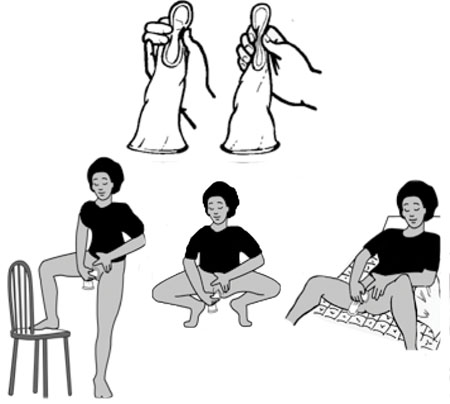
8.3.3 Advantages and disadvantages of female condoms
Advantages
Female and male condoms have many advantages in common. However, the following advantages are specific to female condoms:
- Unlike the male condom, erection is not necessary to keep the condom in place.
- Female condoms do not reduce a male partner’s stimulation.
- Female condoms can be used by people who are known to be sensitive to latex because, while most male condoms are made of latex, female condoms are made of plastic, which rarely causes an allergic reaction.
Disadvantages
These are the most common disadvantages of the female condom:
- Female condoms make a noticeable sound during sexual intercourse.
- It is sometimes difficult to insert or use, and some women can have difficulty on the first attempt at self-insertion.
- It can break or leak.
- It is much more expensive than a male condom.
8.4 The diaphragm
8.4.1 Mechanism of use
Although this barrier method is not common in Ethiopia, it is helpful for you to learn about some of the basics of the diaphragm. The diaphragm is a small dome-shaped latex cup with a flexible ring that fits over the cervix. The cup acts as a physical barrier against the entry of sperm into the uterus. A diaphragm is usually used along with spermicide.
8.4.2 Effectiveness
The diaphragm has a relatively high failure rate, about 16% over the first year of use. However, it is considered a good choice by women whose health or lifestyle prevents them from using more effective hormonal contraceptives.
8.4.3 How to insert a diaphragm
During the fitting process, a fitting ring is inserted into the vagina. The largest ring that fits comfortably is usually the size chosen. Diaphragms can be inserted up to two hours before sex, because spermicide is only effective for two hours. If the woman inserts her diaphragm more than two hours before intercourse, she will have to insert more spermicide into her vagina later (see Box 8.2 for guidelines). As a general rule, diaphragms should be replaced every one to two years.
Box 8.2 Guidelines for diaphragm insertion
- Before or after each use, the woman should hold the diaphragm up to the light, or fill it with water, to check for holes, tears or leaks.
- A small amount of spermicide (about one tablespoon) is usually placed inside the cup, and some is smeared around the lip of the cup.
- The device is then folded in half and inserted into the vagina by hand, or with the assistance of a plastic inserter.
- The diaphragm should fit over the cervix, blocking entry to the uterus.
- If more than six hours pass before repeat intercourse occurs, the diaphragm can be left in place, and extra spermicide inserted into the vagina using an applicator.
- The diaphragm must remain in the vagina for six to eight hours after the final act of intercourse, and can safely stay there up to 24 hours after insertion.
- The diaphragm should be washed with soap and warm water after each use, and then dried and stored in its original container, which should be kept in a cool dry place.
8.4.4 Advantages and disadvantages of the diaphragm
Advantages
The diaphragm can be carried in a purse, can be inserted up to two hours before intercourse begins, and usually cannot be felt by either partner. It also does not interfere with a woman’s hormones.
Disadvantages and complications
Common complications when using a diaphragm are that some women dislike having to insert the device every time they have intercourse, or have trouble mastering the insertion and removal process. The diaphragm can also be dislodged during sex and the failure rate is high, about 16%. Additionally, the diaphragm does not protect against STIs. Frequent urinary tract infections and vaginal infections can be a problem for some women when using a diaphragm.
8.5 Spermicides
8.5.1 Mechanism of use
Spermicides are sperm-killing chemicals inserted deep into the vagina, near the cervix, before sex. They are available in foaming tablets, melting or foaming suppositories, melting film, jelly and cream. Jellies, creams and foam from cans can be used on their own, with a diaphragm, or with condoms. Films, suppositories, foaming tablets or foaming suppositories can be used on their own or with condoms.
8.5.2 Effectiveness of spermicides
They work by causing the membrane of the sperm cells to break, killing them or slowing their movement. This keeps the sperm from meeting the egg.
![]() Spermicides should not be used alone as the primary method of birth control.
Spermicides should not be used alone as the primary method of birth control.
Spermicides are one of the least effective family planning methods, with a 29% chance of pregnancy, and as with other methods effectiveness depends on the user. Risk of pregnancy is greatest when spermicides are not used with every act of sex. In general, spermicides may be an appropriate choice for women who need back-up protection against pregnancy (for instance, if they forget to take their birth control pills). Spermicides should not be used alone as the primary method of birth control.
8.5.3 Advantages and disadvantages of spermicides
Spermicides are safe to use. They are a female-controlled method that almost every woman can use without the need to consult a healthcare provider first. They can increase vaginal lubrication, so that vaginal dryness and friction will be minimised. They are much easier to use with a little practice and can be stopped at any time. They have no hormonal side effects. Unfortunately they are one of the least effective methods on their own.
Summary of Study Session 8
In Study Session 8, you have learned that:
- Barrier contraceptives are broadly classified into two types: mechanical barriers and chemical barriers. Mechanical barriers are devices that provide a physical barrier between the sperm and the egg while chemical barriers are known as sperm-killing substances or spermicides.
- The male condom is the main barrier method for men. It is a sheath that fits over the penis. It works by creating a barrier between partners so that bodily fluids, such as semen and blood, are not shared.
- Condoms can be very effective in preventing pregnancy and STDs when used consistently and correctly.
- The most important message to tell your client is that the condom must be used from ‘start to finish’ with every act of intercourse to effectively prevent pregnancy and STIs.
- One of the advantages of male condoms is that men of any age can use them, and using condoms enables a man to take responsibility for preventing pregnancy and diseases.
- The disadvantage of using male condoms is that a man’s cooperation is needed for a woman to protect herself from pregnancy.
- A female condom provides a barrier between partners to prevent sharing bodily fluids like semen and blood. This ensures that STIs are not passed on, and that pregnancy does not occur. It is also the only female-controlled device offering this protection.
- The female condom is useful because, unlike the male condom, erection is not necessary to keep the condom in place.
- The diaphragm is a small dome-shaped latex cup with a flexible ring that fits over the cervix. The cup acts as a physical barrier against the entry of sperm into the uterus. A diaphragm is usually used along with a spermicide.
- Spermicides are sperm-killing substances which work by causing the membrane of sperm cells to break, killing them or slowing their movement. This keeps the sperm from meeting an egg.
Self-Assessment Questions (SAQs) for Study Session 8
Now that you have completed this study session, you can assess how well you have achieved its Learning Outcomes by answering these questions. Write your answers in your Study Diary and discuss them with your Tutor at the next Study Support Meeting. You can check your answers with the Notes on the Self-Assessment Questions at the end of this Module.
SAQ 8.1 (tests Learning Outcome 8.1)
What is the major difference between mechanical barriers and chemical barriers? In what circumstances is each most effective?
Answer
The major difference between mechanical barriers and chemical barriers is that mechanical barriers are devices that provide a physical barrier between the sperm and the egg, while chemical barriers act as sperm-killing substances. Barrier methods can be more effective when used together with other contraceptive methods, such as oral contraceptives. Spermicides can also be used together with other mechanical barriers.
SAQ 8.2 (tests Learning Outcomes 8.2, 8.3)
You have already learnt that condoms have a number of advantages. Discuss the unique advantage that they have over other contraceptive methods.
Answer
The unique advantage of condoms is that they can be used for birth control and at the same time prevent STIs, including HIV/AIDS.
SAQ 8.3 (tests Learning Outcome 8.3)
Counselling on the use of contraceptives is one of the services that you need to provide. During counselling, a client asks whether a male condom can be used more than once. She also asks if it can be used with the female condom, and if using two male condoms (one of top of the other) gives better protection. What are the key messages you should pass on?
Answer
The key messages to pass on when counselling clients who want to use male condoms are:
- Used condoms should be thrown away after each sex act.
- Male and female condoms should not be used at the same time.
- Placing two male condoms on a penis increases the chance of tearing.
SAQ 8.4 (tests Learning Outcome 8.3)
What is the most common reason for breakage of a male condom? What can a couple do about it?
Answer
The most common reason for a male condom breaking is lack of enough lubrication from natural secretions, which results in increased friction. Increased friction in turn causes breakage. To overcome this, users are advised to use a water-based lubricant, such as KY jelly.
SAQ 8.5 (tests Learning Outcome 8.4)
Sometimes, using a female condom is more advantageous for the woman than relying on a male partner to wear a condom. Why? Give your reasons.
Answer
Using a female condom is more advantageous for the woman than relying on a male partner because it is the only female-controlled device offering protection against pregnancy, STIs and HIV/AIDS.
SAQ 8.6 (tests Learning Outcomes 8.1, 8.2, 8.3, 8.4, 8.5 and 8.6)
Which of the following statements is false? In each case explain why it is incorrect.
A Using male and female condoms at the same time gives more protection against pregnancy and STIs.
B Wearing two condoms at a time can’t prevent breakage.
C In order to prevent dryness and friction during sexual intercourse, you have to put on edible oil and vaseline.
D The diaphragm is one of the least effective birth control methods. Besides, it cannot protect against STIs.
E Spermicides can be used alone as a primary protection against pregnancy.
F The mechanisms of action of both male and female condoms are the same, in that both provide a physical barrier between partners so that body fluids, such as semen and blood, are not shared.
G Men should wait for the penis to become erect before they can safely wear a condom. This is not necessary for women, however.
Answer
A is false because wearing both male and female condoms at the same time can increase the likelihood of breakage, as a result of increased friction.
B is true. Wearing two condoms at a time cannot prevent breakage.
C is false because to prevent dryness during sexual intercourse, you should not use edible oil or Vaseline, but rather only water-based lubricants, such as KY jelly.
D is true. The diaphragm is one of the least effective birth control methods.
E is false because spermicides can only be really effective when used with other contraceptive methods, such as oral contraceptives, condoms and diaphragms.
F is true. Both male and female condoms act as physical barriers so semen and blood are not shared.
G is true. Men should wait for the penis to become erect before wearing a condom.